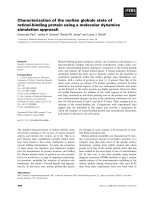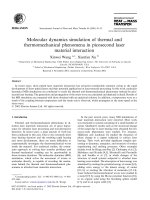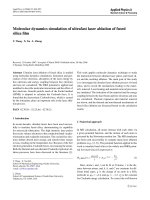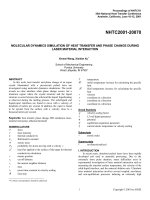Investigating a quickly cooling process of 2D SiC by molecular dynamics simulation
Bạn đang xem bản rút gọn của tài liệu. Xem và tải ngay bản đầy đủ của tài liệu tại đây (741.21 KB, 13 trang )
Investigating a quickly cooling process of 2D SiC by molecular dynamics
simulation
Vo Van On*, Nguyen Ngoc Nguyen and Huynh Thi Phuong Thuy
Group of Computational Physics and Simulation of Advanced Materials, Institute of Applied
Technology, Thu Dau Mot University, Viet Nam
*Corresponding author’s e-mail:
ABSTRACTS
This paper presents the study results of quickly cooling 2D silicon carbide by MD simulation
with a sample of 8100 atoms. Silicon carbide 2D is cooled from 5000K to 300K with a velocity
of 1013 K/s. Investigation of energy dependence on temperature shows a jump in the average
total energy of molten 2D Silicon carbide at the temperature T = 3000K. The radial distribution
function G(r), ring distribution, coordination number distribution, angle distribution, and distance
distribution are also studied. Results show that the phase transition temperature of 2D Silicon
Carbide is about 3000K. At 300K, the 2D Silicon carbide structure is crystal but has many
defects.
Keywords: Silicon carbide, cooling, molecular dynamics, simulation
TĨM TẮT
Bài báo này trình bày kết quả nghiên cứu làm lạnh nhanh cacbua silic 2D bằng mô phỏng MD
với mẫu 8100 nguyên tử. Cacbua silic 2D được làm lạnh từ 5000K đến 300K với vận tốc 1013 K
/ s. Khảo sát sự phụ thuộc năng lượng vào nhiệt độ cho thấy có một bước nhảy trong tổng năng
lượng trung bình của cacbua Silicon 2D nóng chảy ở nhiệt độ T = 3000K. Hàm phân phối xuyên
tâm G (r), phân bố vòng, phân phối số phối trí, phân bố góc và phân bố khoảng cách cũng được
nghiên cứu. Kết quả cho thấy nhiệt độ chuyển pha của 2D Silicon Carbide là khoảng 3000K. Ở
300K, cấu trúc cacbua Silicon 2D là tinh thể nhưng có nhiều khuyết tật.
Từ khóa: Cacbua silic, làm lạnh, động học phân tử, mô phỏng
1. Introduction
Due to its special properties, silicon carbide (SiC) has attracted wide interest in science. SiC
shows the wide range [1] of energy bands from 2.3 eV in the cubic polytype b-SiC to 3.4 eV in
the 2H a-SiC hexagonal. It has been commonly used in high-temperature, high-powered, and
116
high-frequency types of equipment. Theoretical models have also shown that two-dimensional
SiC (2D-SiC) with a honeycomb structure [2- 6], which is equivalent to graphene [7-11] and
silicene [12-19], could be energetically stable[4, 5]. A broad exciton binding energy, in addition
to an appropriate bandgap, is ideal for optoelectronic system applications such as LEDs or solar
cells. The direct bandgap of monolayer 2D-SiC is broad, with an exciton binding energy of up to
2.0 eV [20]. When compared to sphalerite or wurtzite, it also has a higher photoluminescence
(PL). The Bose-Einstein condensate (BEC) effect can be observed in a material system with a
high exciton binding energy, similar to Cu2O [21]. In comparison to silicene and other graphenelike compound semiconductors, monolayer 2D-SiC exhibits a higher in-plane stiffness (GaN,
BP, AlN, etc.). With Perdew-Wang 91 (PW91) gradient corrections, DFT has recently examined
the magnetic characteristics of ordered vacancies in 2D hexagonal structures (graphene, 2D-SiC,
etc.). In 2D-SiC, the local magnetic moment only occurs in the presence of silicon-vacancy [22].
Recent advances in the processing of ultrathin layered 2D-SiC down to a single layer [23] make
it a promising candidate for both basic research and practical applications as an emerging
semiconductor [24-25]. V.V.Hoang et al. used molecular dynamics (MD) simulations to study
the formation and atomic structure of two-dimensional (2D) tetra-SiC (containing entirely
tetragons) [26], and Tue Minh Le Nguyen et al. used the Vashishta potential to simulate the
melting of 2D SiC and obtained a phase transition temperature of about 4050K[27]. There is no
MD simulation investigation of liquid SiC rapidly cooling from 5000K to room temperature at a
rate of roughly 1013K/s. Although this rapid cooling rate can generate crystalline SiC, the lattice
failure rate will be considerable. This is the motivating factor for this paper's research.
2. Materials and methods
The process of rapid cooling of the two-dimensional SiC has been investigated by the MD
method. The model of a 2-dimensional SiC lattice contains 8100 atoms, including 4050 Si atoms
and 4050 C atoms with Vashishta interaction potential, periodic boundary. The model is first to
relax at a temperature of 5000K in 105 simulation steps. Next, SiC is cooled from a temperature
of 5000K to 300K at a speed of 1013 K/s with 495 thousand simulation steps. Periodic boundary
conditions (PBCs) are applied in the x and y Cartesian directions, and in the z-direction, a fixed
boundary with elastic reflection behavior is applied. Atoms interacted via the Vashishta
potential, and effective interatomic interaction potential consists of two- and three-body
interactions. The total potential energy of the system is given by,
117
V = Vij( 2) (rij ) +
i j
V
i , j k
( 3)
ijk
(rij , rik )
(1)
Here the first and second terms in the right hand of (1) are the two-body interaction potential
and the three-body interaction potential, respectively. This potential has been widely used for the
simulation of SiC for the last years; details of this potential can be seen in [28]. The classical
MD method with the Verlet algorithm is used. The temperature is corrected via simple velocity
rescaling. The model cools down from 5000K to 300K. We use a zero-pressure NVT ensemble
simulation for the cooling simulation, LAMMPS software is used for the MD simulations [29],
and ISAACS software is used to calculate the ring statistics [30]. VMD software is used for the
2D visualization of the atomic configurations [31].
3. Results and discussions
3.1. Investigate the correlation between the average total energy per atom and the
temperature
Figure 1 shows the dependence of total energy on temperature when cooling silicon carbide
in molecular dynamic simulation at velocity 1013 K/s.
Figure 1. Temperature dependence of total energy when cooling 2-dimensional SiC model
From figure 1, we see that when cooling the model from 5000K, the curve leaves the
tangent at the temperature of 3497K in the upper part. When continuing to cool the model, the
curve leaves the tangent at the temperature of 2510K in the lower part. Thus, the phase transition
temperature of 2D Silicon Carbide is the average of these two temperatures; it is about 3000K.
118
3.2 The temperature dependence of the radial distribution function when cooling
SiC model
Figure 2 shows the radial distribution at different temperatures when cooling the SiC model.
Figure 2. The temperature dependence of the radial distribution function on rapid cooling of a 2D SiC
model
We can investigate the structural change of the model during the cooling process. At 5000K, the
radial distribution function has only the first peak with a relatively small peak, indicating that the model is
in a liquid state. When the model is cooled, the first peak height increases, accompanied by a sharp
formation of the second and third peaks. The second peak is more pronounced in the region near the
freezing point, T = 3000K, and a third peak exists. At later transition temperatures, peaks form more and
more markedly. At 300K, which are discrete pointed peaks, show that the crystalline SiC has entirely
formed in the model of 2D SiC.
3.3 The angle distribution function
Figure 3 shows the bonding angle distribution between atoms at temperatures of 5000K,
3000K, 2900K, and 300K.
119
b
a.
d.
c.
Figure3. The distribution of the bonding angle of SiC at temperatures 5000K, 3000K, 2900K and 300K
At 5000K, the bond angle Si - C - Si distributes mainly in 500 to 1800. The curve has
continuous variation. The angle value of Si - C - Si increases and decreases continuously. Most
concentrated at the value of 800, accounting for 1.18%, but the peak has not formed clearly. At
the phase transition temperature of 3000K, the top of the curve forms more pointed, reaching a
maximum of 118.60 with 1.18%. After the phase transition temperature, T = 2900K, the bonding
angle is distributed mainly in the range from 59.40 to 1740, the peak of the curve reaches 2.34%
at the angle value of 114.60. At 300K, the bond angle distributes mainly in 1100 to 1300, reaching
a maximum of 7.3 % at an angle of 1200.
3.4 The distribution function of average angle
Figure 4 shows the change of the average angle on the temperature. The graph is also
plotted for 20 different temperatures.
120
Figure 4. The dependence on temperature of average angle
The values of the mean angle ranged around 117.90 before the phase transition. After the
phase transition, this value is about 119,340. When reducing the temperature from 5000K to
300K, the average angle tends to increase intermittently.
3.5 The distribution function of coordination number
Figure 5 shows the distribution of coordination numbers at temperatures 5000K; 3000K;
2900K, and 300K.
b
a
121
c
d
Figure 5. The distribution of coordination numbers of SiC at different temperatures
At 5000K, the values of coordination number x = 1, 2, 3, 4, 5 had uneven distribution. The
values x = 2 and x = 3 accounting for a nearly equal proportion, about 43.73%, while x = 1, x =
4, x = 5 accounts for 4%, 7% and 1% respectively. At the phase transition temperature T =
3000K, the values x = 2 and x = 4 tend to decrease gradually, with the values 19.22% and 5.43%
respectively. Along with that, the values x = 1 and x = 5 decrease and gradually disappear. On
the contrary, the x = 3 value has been continuously increasing and reaching 74.57%. At 2900K,
x = 3 reaches 80.04%, x = 2 tends to decrease slightly, reaching 14.26%. From T = 2900K, the
values tend to stabilize gradually, without much change. At 300K, x = 2 decreases to 4%. Value
x = 3 increases continuously, reaching 95.47%. X = 4 is worth about 1%. Values x = 1, 5, 6, 7…
disappear gradually.
3.6 The distribution function of average coordination number
Figure 6 is a graph showing the change in the distribution of the average coordination
number on the temperature. The graph is also plotted for 20 different temperatures.
122
Figure 6. Temperature dependence of mean coordinate number
Before phase transition, the value of the mean coordinate number varies around 2.69. After
the phase transition, this value is about 2.96. The average coordination number tends to increase
with decreasing temperature from 5000K to 300K. Under the phase transition temperature, the
average coordination number is nearly 3, which indicates that the system has turned to a solid
state with a honeycomb structure.
3.7 The distance distribution function
Figure 7 shows the distribution of distance at different temperatures 5000K; 3000K; 2900K
and 300K.
b.
a.
123
d.
c.
Figure 7. The distance distribution functions of SiC at different temperatures
At 5000K, the distribution is mainly concentrated in the range 1.6 Å to 2.49 Å. The peak is
at a distance of 1.87 Å and accounts for 2.46%. At the phase transition temperature T = 3000K,
the peak of the curve is more pronounced, reaching the maximum at 1.85 Å with 2.93%. At
2900K, the peak height decreased slightly, the value at 1.82 Å reached 2.93%. At 300K, the peak
bottom tended to be smaller, the peak at 1.87 Å reaches 7.8%; at this time, the model is in solidstate.
3.8 Average distance distribution function
Figure 8 shows the dependence of the average distance on the temperature, which plots for
20 different temperature points.
Figure 8. Depends on the temperature of the average distance
124
Before phase transition, the value for the mean distance is about 2.08Ǻ. After phase
transition, this value is about 1.96 Ǻ. When reducing the temperature from 5000K to 300K, the
average distance tends to decrease intermittently. There is a jump at the phase transition
temperature of 3000K.
3.9 The distribution function of the ring number
Figure 9 shows the ring number distribution function at temperatures 5000K; 3000K;
2900K and 300K.
b.
a.
d.
c.
Figure 9. The change of ring number of SiC at different temperatures 5000K; 3000K; 2900K; 300K
At 5000K, a ring number of 3 is the majority, up to 82.28%; different rings account for a
tiny, insignificant proportion. At the phase transition temperature T = 3000K, the ring number of
3 decreases to 55.2%, while the ring number of 6 increases rapidly, reaching 23.57%. After the
phase transition temperature, at 2900K, ring number of 6 still tends to increase rapidly and
125
reaches 63.11%, one of 3 decreases to 8.76%. At 300K, ring numbers 3, 4, 5 plummets, while
the ring number of 6 skyrockets and accounts for 97.61%.
3.10 The distribution function of the average ring number
Figure 10 shows the change of the average ring number on the temperature, which plots for
20 different ones.
Figure 10. The temperature dependence of the mean ring number
Before the phase transition, the average ring number is around 3.85; it approaches 4.5 at the
phase transition temperature T = 3000K; after the phase transition, this value is about 5.66. The
average ring number tends to increase with decreasing temperature from 5000K to 300K. The
average ring value is close to 6 at 300K, a characteristic form of a 2-dimensional honeycomb
structure.
3.11 Visualization configure of 2D SiC
Figure 11 shows the visual configuration of SiC at temperature 300K by VMD software.
126
Figure 11. Some types of defects in 2 dimensional SiC model at 300 K
At 300K, the atomic structure of SiC is also crystalline; the ring number of 6 is the majority
but has some form of defects like ring numbers 4, 7, 8.
4. Conclusions
The process of rapidly cooling two-dimensional SiC model with 8100 atoms with Vashishta
interaction potential from 5000K to 300K with 470 thousand simulation steps and a speed of 1013
K/s some conclusions can be drawn:
− The phase transition temperature of two-dimensional SiC at the velocity 1013K/s is
about 3000K;
− As the temperature decreases, SiC gradually forms a crystal structure;
− At 300K, the atomic structure of SiC is crystalline; the ring number of 6 dominates but
has some form of defects like ring 4, ring 7, ring 8.
Acknowledgment: This research is funded by Thu Dau Mot University, Binh Duong
Province, Vietnam, and used resources of the high-performance computer cluster (HPCC) at
Thu Dau Mot University, Binh Duong Province, Vietnam.
References
[1] P.A.Ivanov and V. E. Chelnokov. Semicond. Sci. Technol. 1992; 7, 863–880
[2] A. Wander, F. Schedin, P. Steadman, A. Norris, R. McGrath, T. S. Turner, G. Thornton and
NM. Harrison. Phys. Rev. Lett. 2001; 86, 3811
[3] Y.Miyamoto and B. D. Yu. Appl. Phys. Lett. 2002; 80, 586
127
[4] F. Claeyssens, C. L. Freeman, N. L. Allan, Y. Sun, M. N. R. Ashfolda and J. H. Hardingb,
J. Mater. Chem. 15, 139–148
[5] C. L. Freeman, F. Claeyssens and N. L. Allan. Phys. Rev. Lett. 2006; 96, 066102
[6] C.Tusche, H. L. Meyerheim and J. Kirschner. Phys. Rev. Lett. 2007; 99, 026102
[7] K. S. Novoselov, A. K. Geim, S. V. Morozov, D. Jiang, M. I. Katsneison, I. V. Grigorieva,
S. V. Dubonos and A. A. Firsov. Nature. 2005; 438, 197–200
[8] K. F. Mak, M. Y. Sfeir, Y. Wu, C. H. Lui, J. A. Misewich and T. F. Heinz 2008 Phys. Rev.
Lett. 101, 196405
[9] R. R. Nair, P. Blake, A. N. Grigorenko, K. S. Novoselov, T. J. Booth, T. Stauber, N. M. R.
Peres and A. K. Geim. Science. 2008; 320, 1308
[10] Y. Zhang, Y. W. Tan, H. L. Stormer and P. Kim. Nature. 2005; 438, 201–204
[11] X. Lin, Y. Xu, A. A. Hakro, T. Hasan, R. Hao, B. Zhang and H. Chen. J. Mater. Chem.
2013; 1, 1618–1627
[12] H. Nakano, T. Mitsuoka, M. Harada, K. Horibuchi, H. Nozaki, N. Takahashi, T. Nonaka, Y.
Seno and H. Nakamura. Angew. Chem. 2006; 118, 6451–6454
[13] B. Lalmi, H. Oughaddou, H. Enriquez, A. Kara, S. Vizzini, B. Ealet and B. Aufray. Appl.
Phys. Lett. 2010; 97, 223109
[14] Z. Ni, Q. Liu, K. Tang, J. Zheng, J. Zhou, R. Qin, Z. Gao, D. Yu and J. Lu. Nano Lett. 2012;
12, 113–118
[15] P. Vogt, P. Padova, C. Quaresima, J. Avila and E. Frantzeskakis. Phys. Rev. Lett. 2012; 108,
155501
[16] H. Sahin, S. Cahangirov, M. Topsakal, E. Bekaroglu, E. Akturk, R. T. Senger and S. Ciraci.
Phys. Rev. B: Condens. Matter Mater. Phys. 2009; 80, 155453
[17] R. Quhe, R. Fei, Q. Liu, J. Zheng, H. Li, C. Xu, Z. Ni, Y. Wang, D. Yu, Z. Gao and J. Lu,
Sci. Rep. 2012; 2, 853
[18] M. Xu, T. Liang, M. Shi and H. Chen, Chem. Rev. 2013; 113, 5 3766–3798
[19] F. Bechstedt, L. Matthes, P. Gori and O. Pulci. Appl. Phys. Lett. 2012; 100, 261906
[20] H. C. Hsueh, G. Y. Guo and S. G. Louie. Phys. Rev. 2011; B 84, 085404
[21] E. Fortin, S. Fafard and A. Mysyrowicz. Phys. Rev. Lett. 1993; 70, 3951
[22] N. S. Eliseeva, A. A. Kuzubov, S. G. Ovchinnikov, M. V. Serzhantova, F. N. Tomilin and
A. S. Fedorov. JETP Lett. 2012; 95, 555–559
[23] X. H. Sun, C. P. Li, W. K. Wong, N. B. Wong, C. S. Lee, S. T. Lee and B. K. Teo, J. Am.
Chem. Soc. 2002; 124, 14464–14471
[24] I. J. Wu and G. Y. Guo. Phys. Rev. 2007; B 76, 035343
[25] L. Sun, Y. Li, Z. Li, Q. Li, Z. Zhou, Z. Chen, J. Yang and J. G. Hou. J. Chem. Phys. 2008;
129, 174114
[26] Vo Van Hoang, To Quy Dong, Vo Hoang Giang, Tran Thi Thu Hanh. Comput. Mater. Sci.
2019; DOI: 10.1016/j.commatsci.2019.02.037
[27] Tue Minh Le Nguyen, Vo Van Hoang and Hang T.T. Nguyen, Eur. Phys. J. 2020; D 74,
108
[28] P. Vashishta, P., Kalia, R. K., Nakano, A., & Rino, J. P. J. Appl. Phys. 2007; 101, 103515
[29] S. Plimpton 1995 J. Comput. Phys. 117, 1
[30] S. Le Roux, V. Petkov 2010 J.Appl.Crystallogr. 43, 181
[31] W. Humphrey, A. Dalke, K. Schulten 1996 J. Mol. Graphics 14, 33.
128









